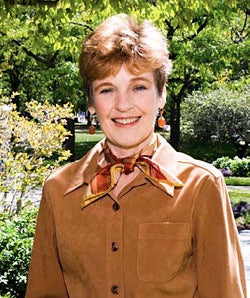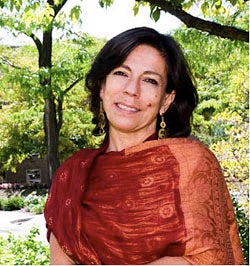Changing the Culture
New Department Chairs in Chemistry and Mathematics
Earlier this fall, when the Flora Stone Mather Center for Women compiled its annual "Women of Achievement Honor Roll," the list included, for the first time, the chairs of the chemistry and mathematics departments. Mary D. Barkley, the Roger M. Clapp University Professor in chemistry, and Daniela Calvetti, professor of mathematics, assumed their new leadership duties this past summer.
Barkley already had a place in the history of breakthroughs for women faculty: In 1996, she became the first woman ever appointed to a tenure-track position in chemistry. Barkley had previously spent 13 years at Louisiana State University, but she wanted to continue her career in a setting with greater opportunities for collaboration with senior biomedical researchers. She was drawn to Case Western Reserve, in part, by its medical school, and started working with the Center for AIDS Research soon after her arrival.
At that time, the appointment of a woman to a senior position was noticed well beyond the chemistry department. Barkley says that her presence was "very encouraging to some women students, and also to some women faculty in other departments," who were operating in what she calls "a very difficult environment." She adds, "It's hard for me to imagine that I had that much impact on anything. But I think the role model part of it, the symbolic part, was significant."
It is still significant today. Women graduate students sometimes write to Barkley after they have finished their degrees. She doesn't necessarily know them well; she may simply have served on their dissertation committees. Nonetheless, they send her e-mails saying, "Thank you for coming to Cleveland."
Barkley has long been active in ACES (Academic Careers in Engineering and Science), a program that aims to increase the number of women in tenure-track positions and eliminate barriers to their success. Funded by a National Science Foundation ADVANCE award, ACES encourages departments to promote diversity through their recruitment and hiring practices. It also provides women faculty with mentors and coaches who advise them about career development (obtaining grants, getting published, networking) and work/life issues (balancing research, teaching, and family responsibilities).
Ongoing changes in the culture of research universities, sparked by ACES and similar initiatives, are benefiting men as well as women, Barkley says. After all, male scientists face work/life issues, too: "They want to be parents. And it's very hard when you're told that you have to work 80 hours a week, and that if you have any other interests, you're not fit or you're not serious about your career."
Barkley also thinks that universities are acting in their self-interest when they seek to alter traditional attitudes and practices. "Academic institutions are where most of the cutting-edge research is done," she says. "But if we don't make them places where bright people want to work, they will take jobs elsewhere, and we won't be globally competitive."
A Repertoire of Techniques
Like many of her colleagues in chemistry, Barkley crosses disciplinary boundaries in her research. "I'm a biophysical chemist," she explains, "and I study various biological problems. So my approach has always been to use whatever tools I need to answer the question. I'm constantly expanding my repertoire of techniques."
Supported by a four-year, $1.029 million grant from the National Institutes of Health, Barkley is currently investigating the mechanism by which HIV and other viruses replicate. Scientists have long known that HIV copies its genetic material into the genomes of healthy cells, turning those cells into virus-producing factories. The process is initiated by an enzyme called reverse transcriptase (RT), and sustained by other enzymes, such as protease. The "drug cocktails" currently used to treat HIV infection contain inhibitors that block this activity. But in order to create more effective drugs, scientists need a better understanding of how the enzymes work.
Barkley has spent years studying enzymes and other proteins, but she calls reverse transcriptase (RT) "the most difficult protein I've ever worked on." RT consists of two subunits that come apart and recombine in different ways. Before Barkley and her colleagues could thoroughly analyze its structure and function, they had to learn how to control that process. Now that they have done so, Barkley says, "we have the understanding to really move forward."
Although she could have established her lab in a department other than chemistry, Barkley sees an advantage to working with chemistry graduate students. They have a strong foundation in mathematics—and math is critical to her research. To Daniela Calvetti, this would not come as a surprise.
Appreciating the Possibilities
Calvetti finds that mathematics is having a larger impact than ever, both on academia and on the larger society. She has been struck, for instance, by the success of Hollywood films about mathematicians, such as Proof and A Beautiful Mind. "In the past few years, math has become cool," she remarks, sounding pleasantly surprised. "It never used to be cool." The number of math majors in the College is on the rise, and undergraduates who didn't focus on math in high school sometimes ask Calvetti whether they can begin now.
She answers their question by citing her own experience. In her native Italy, Calvetti attended a high school with a strong classics curriculum; her early interests were in Greek and Latin, art history, and philosophy. But then, she says, "I started reading philosophy of science, and I realized that I could not understand what these people were talking about because my expertise in math was too limited." Wanting to become "a more well-rounded person," she decided to study math in college. And because Italian universities require undergraduates to immerse themselves in a single subject, math was all she studied.
"My days became very long," Calvetti says. "I had to make up for everything I had not learned in high school. But I enjoyed the challenges more and more. By the time I got my degree, I knew I wanted to do mathematical research." She went on to earn her doctorate at the University of North Carolina at Chapel Hill and came to Case Western Reserve in 1997.
Since then, Calvetti has often reflected on the differences between Italian and American universities. "In the beginning," she says, "I thought the Italian educational system was better, because by the end of four years of college, one comes out with a deeper training in the particular field one has chosen. But as I get older and perhaps wiser, I am starting to appreciate the possibilities that the American educational system gives to students. They can start in one field, and then add on from a different area. This is very important in a world like today's world, where expertise in different fields can be helpful."
The Other Side of the Fence
Calvetti calls the math department "a diverse family," made up of pure and applied mathematicians with a variety of interests. Both groups are involved in a growing network of collaborators within the United States and abroad.
Until recently, Calvetti and other applied mathematicians did most of their interdisciplinary work with colleagues in physics and engineering. The current interest in energy research—a priority in the university's new strategic plan—will foster even more collaborations of this kind. But math is also combining with other fields where its presence hasn't been as strongly felt. In medical research, for example, mathematical modeling is taking the place of animal and human experiments that would be unethical or prohibitively expensive. In psychology and cognitive science, students are increasingly eager to learn and apply quantitative methods.
To Calvetti, this trend is both challenging and exciting. "In the next few years," she says, "we will build ties with departments that have traditionally been on the other side of the fence."
In a book published earlier this year, Calvetti and math department colleague Erkki Somersalo examined ways to incorporate human intuition into problem-solving—even when the problem-solving is done by computers. But her research interests also include medical imaging and the mathematical modeling of biochemical processes in the brain. Currently, she is working with faculty members in cognitive science, where she holds a secondary appointment, to understand how changes in the brain's metabolic pathways relate to "emotions, functions, and stimuli."
Calvetti says that projects of this kind "transmit the idea that mathematical expertise can help in different fields." And she welcomes the chance to contribute to such projects as a mathematician, without pretending to be a cognitive scientist or an engineer. Recently, Calvetti heard a recorded interview with the sculptor Henry Moore, who said that when he looked at an object or a landscape, he translated everything into shapes. The remark caused her to reflect on her own distinctive cast of mind: "Whatever problem I am presented with," she says, "I think about how it can be formulated in the language of mathematics."
As chair, Calvetti wants to highlight the full range of her department's activities and dispel any lingering impression that mathematicians are locked away in an ivory tower. There is no such tower, she says. Or, if there is, "there are ramps that allow us to come down, and other people to come up, without struggling too much."
Two new department chairs were recently named in the humanities as well: Antonio Candau in modern languages and literatures, and Mary E. Davis in music. Their profiles will appear in the Spring 2009 issue of art/sci.

Mary D. Barkley
Photo: Daniel Milner

Daniela Calvetti
Photo: Daniel Milner
